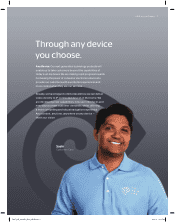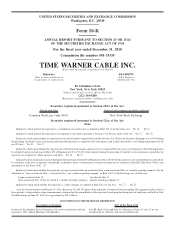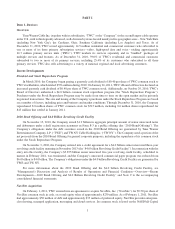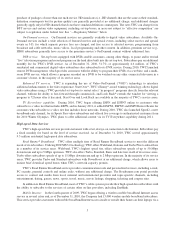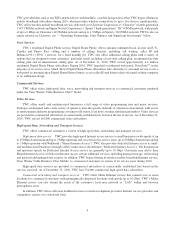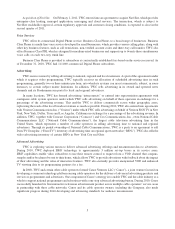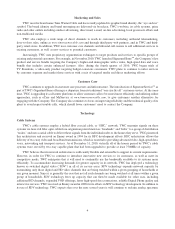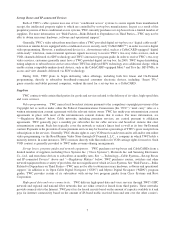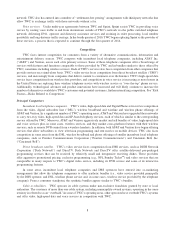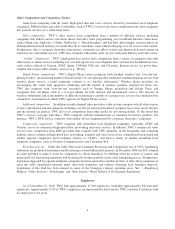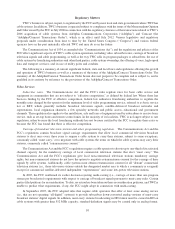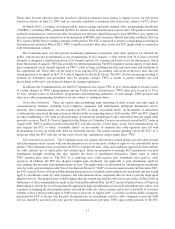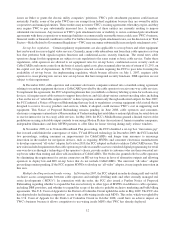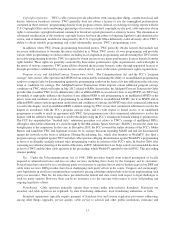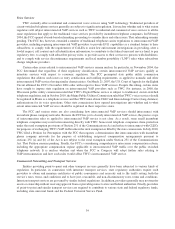Time Warner Cable 2010 Annual Report Download - page 19
Download and view the complete annual report
Please find page 19 of the 2010 Time Warner Cable annual report below. You can navigate through the pages in the report by either clicking on the pages listed below, or by using the keyword search tool below to find specific information within the annual report.Set-top Boxes and IP-connected Devices
Each of TWC’s cable systems uses one of two “conditional access” systems to secure signals from unauthorized
receipt, the intellectual property rights to which are controlled by set-top box manufacturers. In part as a result of the
proprietary nature of these conditional access systems, TWC currently purchases set-top boxes from a limited number of
suppliers. For more information, see “Risk Factors—Risks Related to Dependence on Third Parties—TWC may not be
able to obtain necessary hardware, software and operational support.”
Generally, TWC’s video subscribers must have either a TWC-provided digital set-top box or a “digital cable-ready”
television or similar device equipped with a conditional-access security card (“CableCARD
TM
”) in order to receive digital
video programming. However, a unidirectional device (i.e., downstream-only), such as a CableCARD-equipped “digital
cable-ready” television, cannot transmit upstream signals necessary to receive TWC’s two-way video services, such as
VOD, channels delivered via SDV technology and TWC’s interactive program guide. In order to receive TWC’s two-way
video services, customers generally must have a TWC-provided digital set-top box. In 2009, TWC began distributing
tuning adaptors to subscribers in service areas where TWC has deployed SDV technology at no additional charge, which
enable certain compatible unidirectional devices, such as the CableCARD-equipped Moxi@and Tivo Inc. HD DVRs, to
access and view channels delivered via SDV technology.
During 2011, TWC plans to begin delivering video offerings, including both live linear and On-Demand
programming, directly to subscriber broadband-connected consumer electronic devices, including “Smart TVs,”
game consoles and tablet personal computers, without the need for a set-top box or a CableCARD.
Suppliers
TWC contracts with certain third parties for goods and services related to the delivery of its video, high-speed data
and voice services.
Video programming. TWC carries local broadcast stations pursuant to the compulsory copyright provisions of the
Copyright Act as well as under either the Federal Communications Commission (the “FCC”) “must carry” rules or a
written retransmission consent agreement with the relevant station owner. TWC has multi-year retransmission consent
agreements in place with most of the retransmission consent stations that it carries. For more information, see
“—Regulatory Matters” below. Cable networks, including premium services, are carried pursuant to affiliation
agreements. TWC generally pays a monthly per subscriber fee for cable services and broadcast stations that elect
retransmission consent. Such fees typically cover the network or station’s linear feed as well as its free On-Demand
content. Payments to the providers of some premium services may be based on a percentage of TWC’s gross receipts from
subscriptions to the services. Generally, TWC obtains rights to carry VOD movies and events and to sell and/or rent online
video programming via the Road Runner Video Store through iN Demand L.L.C., a company in which TWC holds a
minority interest. In some instances, TWC contracts directly with film studios for VOD carriage rights for movies. Such
VOD content is generally provided to TWC under revenue-sharing arrangements.
Set-top boxes, program guides and network equipment. TWC purchases set-top boxes and CableCARDs from a
limited number of suppliers, including Cisco Systems Inc. (“Cisco Systems”), Motorola Inc. and Samsung Electronics
Co., Ltd., and rents these devices to subscribers at monthly rates. See “—Technology—Cable Systems—Set-top Boxes
and IP-connected Devices” above and “—Regulatory Matters” below. TWC purchases routers, switches and other
network equipment from a variety of providers, the most significant of which is Cisco Systems. See “Risk Factors—Risks
Related to Dependence on Third Parties—TWC may not be able to obtain necessary hardware, software and operational
support.” In addition to its Open Cable Digital Navigator (“ODN”) and Mystro Digital Navigator (“MDN”) program
guides, TWC provides certain of its subscribers with set-top box program guides from Cisco Systems and Rovi
Corporation.
High-speed data and voice connectivity. TWC delivers high-speed data and voice services through TWC’s HFC
network and regional and national fiber networks that are either owned or leased from third parties. These networks
provide connectivity to the Internet. TWC pays fees for leased circuits based on the amount of capacity available to it and
pays for Internet connectivity based on the amount of IP-based traffic received from and sent over the other carrier’s
7


